Again… and as if for the first time.
Words and photos by Alejandro Strong.
Alejandro Strong, professor of Philosophy at Husson University and owner of Apeiron Expeditions, has worked with HIOBS since 2000 as an instructor, volunteer – and, as our Semester Program Manager. Alex started with HIOBS as a student, hailing from Martin County FL, and taking on the challenge of an expedition canoeing course in Northern Quebec.
This spring, Alex decided to take on a solo canoeing expedition of his own, to challenge himself – to return to some old favorite locations and explore some new stretches of the river… and to spend time in solo reflection.

Alex’s story reminds us that we can always choose to step back from our busy lives with intention to seek some insight and perspective.
Why this trip
For a while now, I have been dreaming of doing a long solo canoe trip on the Penobscot River. As a guide and OB instructor, I have paddled many of the Branches and Lakes of the river. From the tall sandbanks on the East Branch to the views of Katahdin from Chesuncook lake – to the narrow rapids of the South Branch, this river has become an important part of my life. What better place to take my first extended solo trip?
My plan was to start on the South Branch near Canada Falls Lake and paddling to Penobscot bay. The route was meant to be a mix of places I knew without the need of a map and others that I had never seen. With low water and some access issues around dams near Millinocket, I ended up paddling from the bottom stretch of the South Branch to the Dolby dam in East Millinocket.
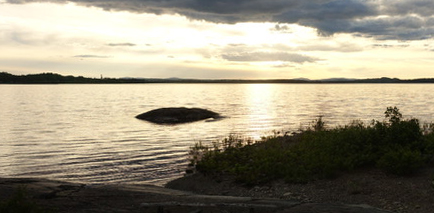
After so many years of expeditioning with groups, I was drawn to do a solo trip for a number of reasons….
One, I thought it would be a challenge. Maybe on par with being a student (and in some ways – it was).
Two, it was meant to be a new way to experience something that is familiar and important to me.
Third, I hoped it could be a chance for reflection – much like those 2 days and nights spent alone as a student on my first solo experience.
The Route
Day 1: The South Branch of the Penobcot River and Seboomook Lake
Leaving early in the morning from my home in Orrington, HIOBS instructor and friend Beth Jackson and I drove 4 hours to the North Maine Woods checkpoint where I picked up permits for the first part of the trip. We left the checkpoint and drove to the Canada Falls Dam, hoping to find enough water to run the whitewater section – but we were out of luck!
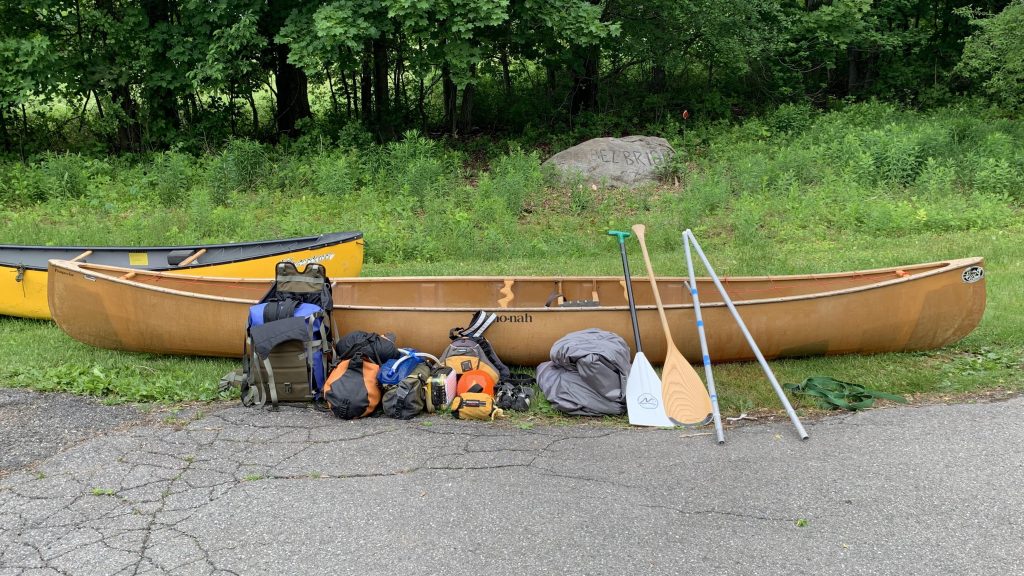
My new starting point became a put in towards the bottom of the South Branch, just below the final set of rapids on the Canada Falls section. I had hoped to start up higher on the rapids, but the water levels were so low – due to the lack of rain this spring – that I was forced to start lower. From this spot there is just a short paddle onto Seboomook Lake.
With a light wind out of the north, I faced a head-wind for the first half of the lake. Despite this I made good time – my canoe easily held its’ line, and made progress.
The lake is long, and narrow – with a slight bend in it. The northmost point is actually in the center of the lake – so once I had made it to the halfway point… I gained a tail wind to help the rest of the way. I arrived at my campsite near the far end of the lake in the early evening – with enough light left in the June sky to set up camp, cook dinner, and reorganize my gear and food for the days ahead.
Day 2: The Upper West Branch of the Penobscot River to Gero Island
Sunrise is early this time of year, and his hard to ignore before 4am! I wanted to cover a good distance on my first full day of the trip – still unsure of what my solo pace would be. So I got up quickly, made coffee, packed my boatr and was off.
The day started with a short paddle (of just a few hundred yards) to reach the portage around the dam. I started by carrying my boat down to the river, then retraced my route with my pack and other gear. There was a stretch of flatwater ahead of me before the first rapid of the day – Double Hydraulic.
Double Hydraulic is a place where I have met (as a whitewater instructor) countless Outward Bound groups over the years – as they start their (often first) whitewater canoeing day. I’m used to lots of people, and canoes, and action in this location – but, unlike a usual day here – now, I was alone. Like all parts of this trip… being by myself increased the risk that I faced. With this in mind – I decided to paddle only the rapids that I was confident I could do… without swimming. The two-mile stretch of rapids took me about two hours to paddle, portage and line my way through.
From the bottom of the rapids, the river continues with occasional quick water in shallow areas – as well as more mellow deep water stretches. Each bend in the river brought a new surprise – from a moose enjoying river grass, to trails of duck families, to countless loons – and (a first for me) a very young bald eagle chick, hopping around on a downed tree alongside the bank of the river. Humans were one species with the lowest number of sightings on the river that day!
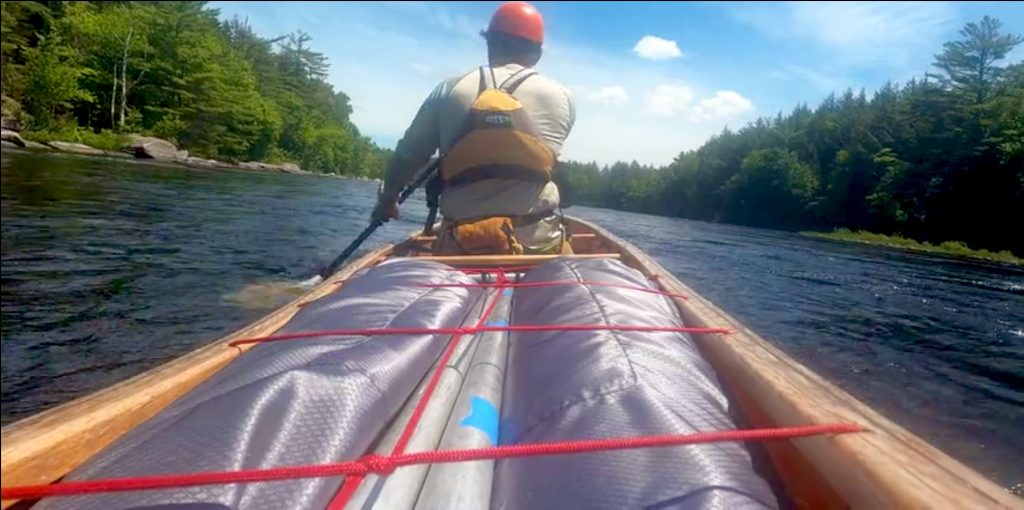
I wouldn’t say my paddling pace was especially fast – and with the low-water current speed not being dramatic… but with the early start and keeping my breaks to a minimum I found myself near the end of the river by the early afternoon. I had initially thought I would camp at Little Ragmuff Stream, or Pine Stream Campsite – but with plenty of time left in the day I pushed on towards Gero Island on Chesuncoook Lake.
Despite a nice breeze at the campsite, the black flies and mosquitos were plentiful. To escape them I quickly ate dinner and jumped into my tent as the light of the day finally faded. Tomorrow would be an early morning.
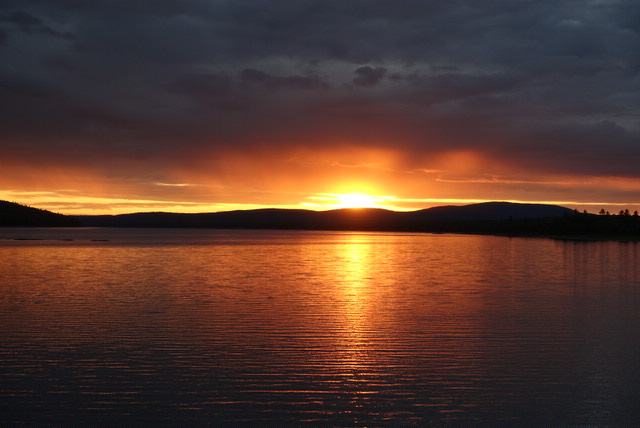
Day 3: Gero Island to Big Eddy
Up again with the light – I was able to be out of camp and paddling while the reds and pinks of the sunrise still reflected from the glassy water of the the lake. Over the years, I have learned to treat Maine’s big lakes with trepidation and reverence. The high pressure system which had brought me good weather over the last few days also brought a strong wind – which could pick up any moment, which would drive a sizable chop down the length of the lake.

This morning – and the day before – I couldn’t help but feel a certain drea about what conditions I would face on Chesuncook. The extra miles the day before, and an early start paid off. I had paddled half the length of the lake before the wind began to fill in.
Matching the silence of the morning, I was able to paddle close enough to shore to see a mother and child moose together, as well as a large group of Canada geese – although their displeasure at seeing me put an end to the quiet for a while!
By the time I crossed into Ripogenous Lake at the south end of Chesuncoook, I was paddling into a significant head-wind. The last few miles on the lake were a struggle making headway… after finally reaching the shore, the real challenge of the day was just about to begin.
Right after the dam, there is a gorge that contains a series of Class 4 and 5 rapids. I portaged my way along the gorge – leap-frogging back and forth with my canoe, then my gear… 1/4 mile at a time. I didn’t get too close to those rapids – the closest I got was looking down on them from above when the portage trail came close to the edge of the gorge.
I stashed my boat at the end of the trail and then walked the rest of the way to Chewonki’s Big Eddy campsite, where I connected with the staff there – sharing stories about acquaintances and adventures. A lovely way to wrap up the trip, and a nice reminder of how interconnected Maine’s outdoor community really is.
Support v Self Reliance
It is important to note on a trip like this it’s hard to be completely self-reliant. With various car rides, route advice, and support along the way—I was able to remain linked with the human world.
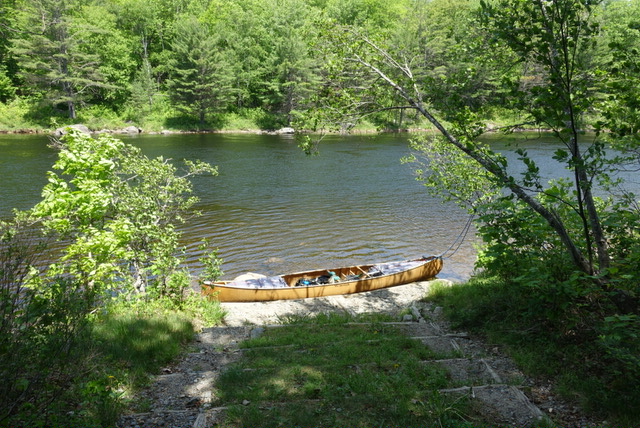
Stay tuned!
As I wasn’t able to complete the sections I had originally hoped in this one trip, my new plan is to return to the sections I was not able to paddle this time over a series of future trips. I hope to share those stories in a future blog post!



